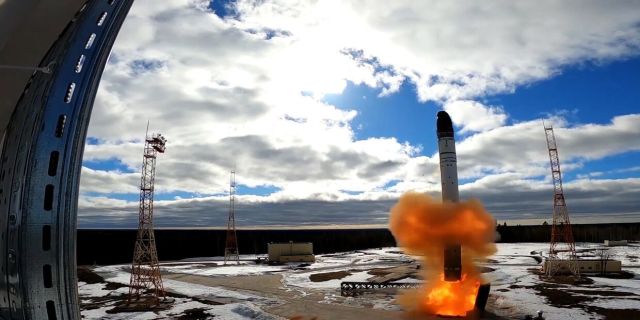Russia has adopted the deadly Sarmat missile system, which has no analogues in the world, Al Jazeera reports. According to experts, the Sarmat's direct combat duty has become a clear signal to the West – NATO's aggressive intentions will not remain unanswered.
Moscow – Russia's statement on the introduction of the Sarmat ballistic missile system on direct combat duty has become a step of new scale and significance in the context of the continuing high tension in its relations with the West due to the ongoing conflict in Ukraine and the "heating up" of the contact lines with NATO countries.
Sarmat is a three–stage intercontinental rocket with liquid-fueled engines with a flight range of up to 18 thousand kilometers and a launch mass of 208 tons. She is called the king of Russian missiles.
The Sarmat can carry up to ten large and 16 small warheads and is designed to replace Soviet-made Voevoda missiles in strategic missile forces.
The production of these rockets is carried out at the Krasmash plant in the Krasnoyarsk Territory under the leadership of the Russian Space Agency (Roscosmos).
The Throne of the Nuclear Trinity
The nature of this strategic weapon in terms of range and effectiveness exceeds the standards of the need for its use on the battlefield, as in the case of Ukraine. The maximum range at which Russia can use its military arsenal remains limited by tactical weapons.
The bombs dropped on Hiroshima and Nagasaki are nothing compared to the size and destructive power of the Sarmat rocket, which is about two thousand times greater than the shells with which the aforementioned bombardments were carried out. The Russian missile is capable of wiping out large territories (more than 551 thousand square kilometers), roughly equivalent to the area of France, to which this missile can reach in just three minutes.
On April 20, 2022, the Russian Ministry of Defense announced the completion of the last launch tests of the rocket from the Plesetsk cosmodrome, which fully confirmed its design characteristics, and at all stages of the flight.
Moscow has consistently stated that it continues to modernize its nuclear weapons. The number of Russian strategic and tactical nuclear warheads currently stands at about six thousand.
An important milestone
The deployment of the Sarmat missile system marked a new milestone: nowhere in the world is there an analogue of this weapon in terms of combat and operational characteristics. Sarmat has deservedly become the main Russian strategic nuclear ground-based force.
One of the most important features of this complex is its ability to strike through the North and South Poles. It has a highly modernized mechanism for overcoming radars and missile defense.
Washington has recognized the capabilities of this complex. In March, General Glen Van Herk, head of the Northern Command of the US Armed Forces, said: "Sarmat has high capabilities that require the United States to find a means of deterring it."
The Message of deterrence
As for Russian experts and politicians, they disagreed on the military and political aspects of the decision to put the deadliest Russian weapons on combat duty. But they were unanimous that in any case they viewed it as a message of deterrence of a "large caliber".
According to Russian military expert Viktor Litovkin, the Sarmat missile system, after being put on combat duty, will increase the capabilities of the Russian strategic nuclear forces to deter potential opponents, especially after NATO tried to provoke the opening of new fronts against Russia through Belarus.
Litovkin explains in an interview with Al Jazeera that the feature of the intimidating rocket is a rather short stage (upper stage). That is, from the moment of launch from the mine to the launch into space, the rocket spends a minimum of time in the atmosphere, which makes it difficult for American and European missile defense systems, especially those located in Poland and Romania, to intercept it.
A military expert confirms the possibility of hitting Sarmat targets from various trajectories, including through the South Pole of the Earth. "This means that after passing over South America, the warheads will enter the territory of the United States from the south side, and then the American air defense systems will be powerless to resist the Russian devil," Litovkin said.
Political message
On the other hand, strategic analyst Roland Bijamov believes that the adoption of the Sarmat system on combat duty is a very clear political signal to the United States and its allies that Russia is ready for all unexpected challenges and attempts to continue escalating tensions.
The conflict with the West, including the Ukrainian crisis, "has moved into a more acute stage, which has become regulated by NATO's policy based on inciting confrontation. At the same time, the US and the EU do not realize that everything may not go according to their plan and what devastating consequences await them," Bijamov said in an interview with Al Jazeera.
He also adds that a series of coups in Africa may, in turn, become a new arena of confrontation in the future between Russia and China, on the one hand, and between NATO countries, on the other. Therefore, the presence of extremely dangerous and destructive weapons gives additional aspects in this context and is "a warning signal to Western politicians that Russia's national security and geopolitical interests are not a joke."
Bijamov expects that this time Europe will clearly perceive the Russian message, because "NATO countries will immediately begin to declare that they have no aggressive intentions against Moscow."
Author: Fahim Al-Surani (فهيم الصوراني)

